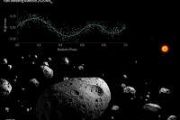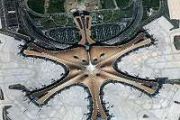
Copernical Team
Video: Lunar impact flash detected on the moon by Armagh Observatory and Planetarium
Verifying that you are not a bot
Measuring radio leaks from 36,000 kilometers up
Verifying that you are not a bot
EscaPADE explorer sort of goes to Mars
Verifying that you are not a bot
Indian dance mudras yield advanced synergies for robotic hand control
 Researchers at the University of Maryland, Baltimore County extracted building blocks from precise hand gestures in Bharatanatyam, a classical Indian dance form. Their analysis revealed a richer set of movement patterns than those in natural grasps. The team published findings online Nov. 24 in Scientific Reports.
Ramana Vinjamuri leads the UMBC lab that studies brain control of complex ha
Researchers at the University of Maryland, Baltimore County extracted building blocks from precise hand gestures in Bharatanatyam, a classical Indian dance form. Their analysis revealed a richer set of movement patterns than those in natural grasps. The team published findings online Nov. 24 in Scientific Reports.
Ramana Vinjamuri leads the UMBC lab that studies brain control of complex ha Satellites help tackle landfill methane leaks

Satellites are emerging as a powerful new tool in the fight to curb emissions of methane. While methane is much shorter-lived in the atmosphere than carbon dioxide, it is vastly more potent at trapping heat, which makes rapid cuts essential for slowing warming in the short term. The same satellite technology that has transformed methane monitoring in the oil and gas sector is now being turned towards another major source – landfill sites.
Bible 1.0: How Ancient Canon Became Our First Large Language Models
 Modern large language models are treated as something radically new: vast statistical machines trained on almost everything humans have written, and able to regenerate knowledge on demand. Yet in structural terms, humanity has worked with something similar for millennia.
Modern large language models are treated as something radically new: vast statistical machines trained on almost everything humans have written, and able to regenerate knowledge on demand. Yet in structural terms, humanity has worked with something similar for millennia. China launches carrier rocket to deploy experimental cargo ship and satellite
 China launched a Kuaizhou 11 carrier rocket on Saturday morning to deploy a privately developed experimental cargo ship and a satellite into space.
The rocket blasted off at 9:08 am at the Jiuquan Space Launch Center in the Inner Mongolia autonomous region and soon placed the DEAR 5 ship and the Xiwang 5B satellite into their preset orbital position, according to China Aerospace Science an
China launched a Kuaizhou 11 carrier rocket on Saturday morning to deploy a privately developed experimental cargo ship and a satellite into space.
The rocket blasted off at 9:08 am at the Jiuquan Space Launch Center in the Inner Mongolia autonomous region and soon placed the DEAR 5 ship and the Xiwang 5B satellite into their preset orbital position, according to China Aerospace Science an Ultra hot super Earth shows dense atmosphere over magma ocean
 A Carnegie-led team using NASAs James Webb Space Telescope has obtained the strongest evidence so far for an atmosphere around a rocky exoplanet, detecting a substantial gaseous envelope around the ultra-hot super-Earth TOI-561 b. The observations, reported in The Astrophysical Journal Letters, indicate that this ancient world is shrouded by a thick atmosphere above a global magma ocean.
T
A Carnegie-led team using NASAs James Webb Space Telescope has obtained the strongest evidence so far for an atmosphere around a rocky exoplanet, detecting a substantial gaseous envelope around the ultra-hot super-Earth TOI-561 b. The observations, reported in The Astrophysical Journal Letters, indicate that this ancient world is shrouded by a thick atmosphere above a global magma ocean.
T Quasar X ray link to black hole environment found to evolve over cosmic time
 Astronomers using new X ray data have found evidence that the structure of matter around supermassive black holes has changed over billions of years, challenging a quasar relationship that has been treated as a fundamental law for nearly 50 years.
Quasars, identified in the 1960s, rank among the brightest known cosmic sources and are powered by supermassive black holes that draw in surroun
Astronomers using new X ray data have found evidence that the structure of matter around supermassive black holes has changed over billions of years, challenging a quasar relationship that has been treated as a fundamental law for nearly 50 years.
Quasars, identified in the 1960s, rank among the brightest known cosmic sources and are powered by supermassive black holes that draw in surroun Hidden circumbinary giant planet emerges from decade old Gemini data
 Astronomers have directly imaged a giant exoplanet orbiting a pair of stars, in a configuration reminiscent of the fictional Tatooine system but with the closest-known directly imaged planet to its twin suns in a binary system. The planet orbits a spectroscopic binary in the Scorpius-Centaurus association and was found buried in data taken nearly a decade ago with the Gemini Planet Imager (GPI)
Astronomers have directly imaged a giant exoplanet orbiting a pair of stars, in a configuration reminiscent of the fictional Tatooine system but with the closest-known directly imaged planet to its twin suns in a binary system. The planet orbits a spectroscopic binary in the Scorpius-Centaurus association and was found buried in data taken nearly a decade ago with the Gemini Planet Imager (GPI) 

































